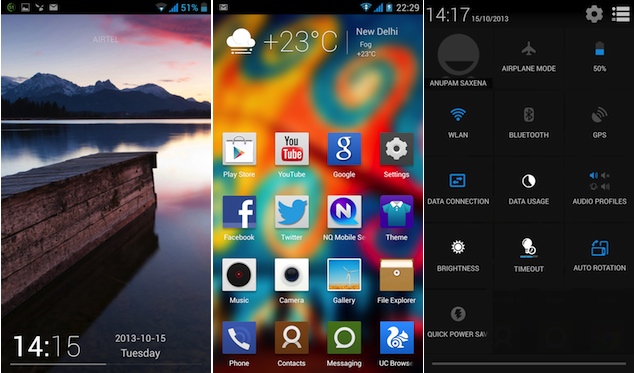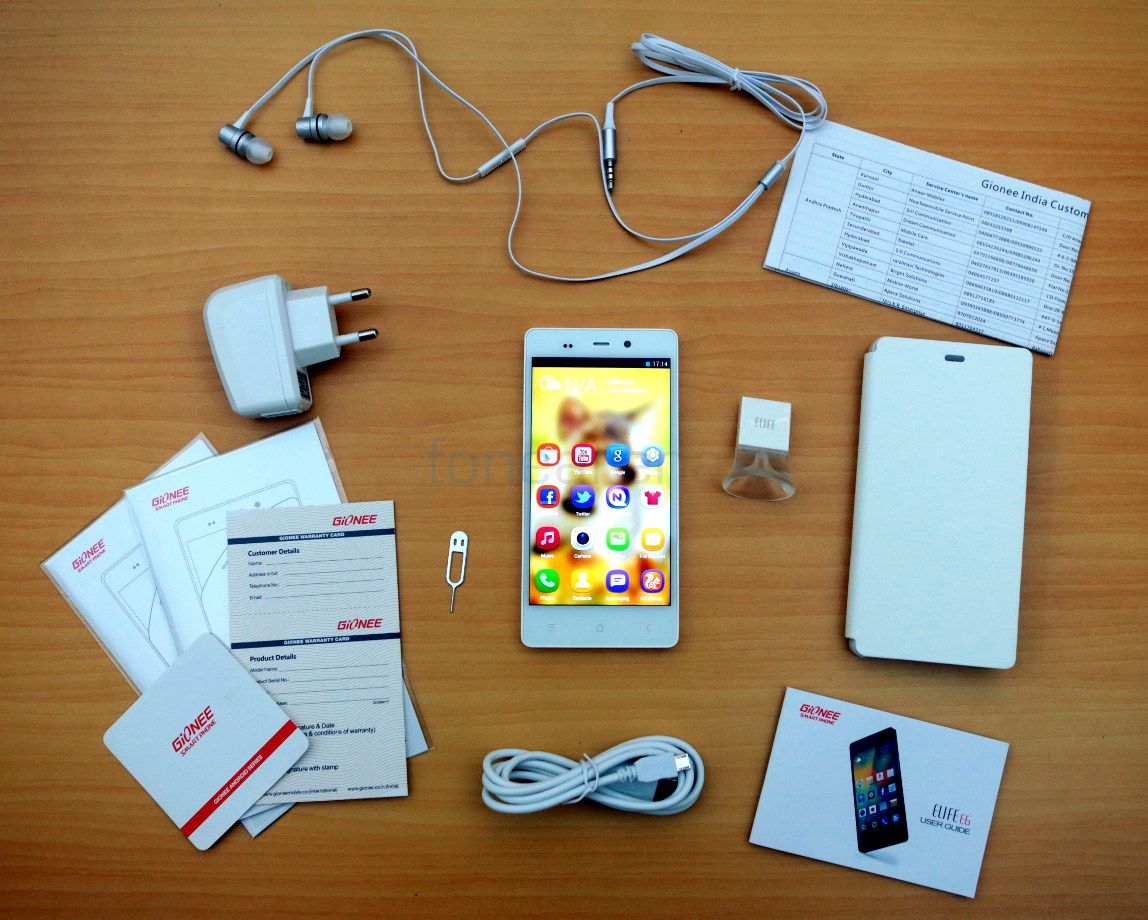Gionee Elife E6 is the latest flagship phone from the
Giant China Manufacturer which has made different statement in indian market in
recent months with some successful products likes Elife E3 and E5 which are the
top selling phones in their product line up. It only 6 months for this brand to
come to india and it has been believed as one of the trusted brand these days
when it come to budget android phones in india. In this review we tell you all
that Gionee Elife e6 comes with and how value for money the device and its
associated features are, read on further to know more.
Gionee Elife E6
Quick Specs
Display Size:
5 inch IPS LCD capacitive touch screen with 1920 x 1080 HD resolution
Processor: 1.5 GHz Quad Core MediaTek Mt6589
RAM: 2 Gb
Software Version: Android 4.2.1 (Jelly Bean) OS
Camera: 13 MP AF camera.
Secondary Camera: 5 MP front-facing camera FF [Fixed Focus] e
Internal Storage: 32 GB with Approx 25 Gb user available
External Storage: No MicroSD Slot
Battery: 2000 mAh battery Lithium Ion
Connectivity: 3G, Wi-Fi 802.11 b/g/n, Bluetooth with A2DP, aGPS, 3.5mm audio jack, FM Radio
Others: OTG Support – No
Processor: 1.5 GHz Quad Core MediaTek Mt6589
RAM: 2 Gb
Software Version: Android 4.2.1 (Jelly Bean) OS
Camera: 13 MP AF camera.
Secondary Camera: 5 MP front-facing camera FF [Fixed Focus] e
Internal Storage: 32 GB with Approx 25 Gb user available
External Storage: No MicroSD Slot
Battery: 2000 mAh battery Lithium Ion
Connectivity: 3G, Wi-Fi 802.11 b/g/n, Bluetooth with A2DP, aGPS, 3.5mm audio jack, FM Radio
Others: OTG Support – No
Software / User
Interface
The Gionee Elife E6
runs a highly-tweaked version of Android 4.2.1 Jelly Bean. The handset maker
has put a custom 'Amigo' skin on top of the UI, and offers themes that let the
user customise the phone's home screen and app icons.
In fact, if you remove the Google services and the Play store, and it would look like a different operating system, similar to Xiaomi's MiUi interface which is based on Android. The phone's OS doesn't offer the traditional Android home screen - app launcher structure, but instead, is a little similar to the iPhone's layout - the Elife E6's home screen is also the app launcher
For users who're switching to the Elife E6 from another Android phone, the arrangement would be a little unsettling but otherwise it might not be much of a problem.
Users can add up to nine home screens, which can be populated with app icons. The Gionee Elife E6 doesn't support widgets, though a weather and time widget stays on top of each of the phone's home-screen. It's also displayed on the lock screen, in addition to another lock-screen widget that offers shortcuts to the camera, torch and sound recorder apps.
The notification tray on the Elife E6 features a settings shortcut and a clear all notifications button, along with expandable notifications (expanded with the two finger pull gesture). It features the same setting toggles shortcuts (plus a few extra) that are found in stock Android for quick access to airplane mode, battery status, Wi-Fi, Bluetooth, GPS, data connection, data usage, audio profiles, brightness, screen backlight timeout, auto rotation, power saving mode and alarm clock.
The option to wirelessly mirror the Elife E6's display with an HDMI-enabled device through a wireless display adapter is also present. This is essentially an Android 4.2 feature.
There's a dock at the bottom if the Gionee Elife E6's interface, where four preferred app shortcuts can be placed. This dock is static across all the home screens. Each home screen can have 12 app icons in addition to the dock.
The lock screen mechanism is also a little different on the Gionee Elife E6. You can either just press the power button to lock the screen or swipe towards the bottom of the screen from the weather+time widget. Swiping up unlocks the screen.
The Gionee Elife E6's UI is full of transition animations and effects and you can even customise some of them. When you tap an app icon, the app pops up from the bottom of the screen. When you exit the app the app window retracts to the bottom again. These effects look gimmicky and jarring, and increase the launch time of apps.
In fact, if you remove the Google services and the Play store, and it would look like a different operating system, similar to Xiaomi's MiUi interface which is based on Android. The phone's OS doesn't offer the traditional Android home screen - app launcher structure, but instead, is a little similar to the iPhone's layout - the Elife E6's home screen is also the app launcher
For users who're switching to the Elife E6 from another Android phone, the arrangement would be a little unsettling but otherwise it might not be much of a problem.
Users can add up to nine home screens, which can be populated with app icons. The Gionee Elife E6 doesn't support widgets, though a weather and time widget stays on top of each of the phone's home-screen. It's also displayed on the lock screen, in addition to another lock-screen widget that offers shortcuts to the camera, torch and sound recorder apps.
The notification tray on the Elife E6 features a settings shortcut and a clear all notifications button, along with expandable notifications (expanded with the two finger pull gesture). It features the same setting toggles shortcuts (plus a few extra) that are found in stock Android for quick access to airplane mode, battery status, Wi-Fi, Bluetooth, GPS, data connection, data usage, audio profiles, brightness, screen backlight timeout, auto rotation, power saving mode and alarm clock.
The option to wirelessly mirror the Elife E6's display with an HDMI-enabled device through a wireless display adapter is also present. This is essentially an Android 4.2 feature.
There's a dock at the bottom if the Gionee Elife E6's interface, where four preferred app shortcuts can be placed. This dock is static across all the home screens. Each home screen can have 12 app icons in addition to the dock.
The lock screen mechanism is also a little different on the Gionee Elife E6. You can either just press the power button to lock the screen or swipe towards the bottom of the screen from the weather+time widget. Swiping up unlocks the screen.
The Gionee Elife E6's UI is full of transition animations and effects and you can even customise some of them. When you tap an app icon, the app pops up from the bottom of the screen. When you exit the app the app window retracts to the bottom again. These effects look gimmicky and jarring, and increase the launch time of apps.
The Gionee Elife
E6's UI borrows its app switcher from Apple's iOS 7 card-based multitasking
menu, which was first seen in webOS and later in BlackBerry PlayBook OS. The
implementation is almost the same with a full window preview of the running
apps being displayed as soon as the Home button is pressed. You can dismiss
apps by throwing their preview windows out of the screen and switch by swiping
horizontally.
We feel that pressing the home button on the Gionee Elife E6 should take users to the first home screen and not open the app switcher. At times, pressing the home button when you're in a system app (messaging, gallery) also opens the app switcher instead of taking you to the home screen/ launcher.
The three capacitive buttons, back, home and menu, help in navigating through the Gionee Elife E6, with the home button also doubling up as an app switcher/ task manager on long press.
The settings menu of the Gionee Elife E6 offers popular settings under the 'common settings' tab and hides the complete set of settings under the 'all' tab. This makes things simple for new smartphone users but increases a step for people familiar with the default Android settings menu.
The phone also includes 'smart gestures' and 'air gestures'. The smart gestures include smart dial (dial a number displayed in a message, contact details page when you bring the phone close to your ear), smart answer (answer the phone automatically when you bring the phone close to your ear), and pause alarm (when you flip the phone). These worked as promise.
The Elife E6 also offers air gestures, as seen in phones like the Samsung Galaxy S4 and even in some economy phones such as the Lava Iris 504. The feature enables users to answer calls or browse pictures by just waving your hand. This didn't work for us at all. The only gesture that worked was the 'smart pause' control that pauses the video when you look away.
Gionee has also bundled some apps with the Elife E6, including UC Browser - the phone's default web browser, File Explorer, Facebook, Twitter, NQ Mobile Security, WhatsApp, Yahoo Cricket, GameZone - a games store to download new games, Fishing Joy game, WeChat, Notes, App Manager, a torch app (to use the LED flash as a flash light), a compass app, Kingsoft Office, a weather app, as well as the GioneeXender app - for transferring content, Du Battery Saver app, and Saavn - the Indian music streaming service.
Some of the native apps on the Elife E6 offer extended functionality. For instance, the Music app allows you to put a sleep timer, if you like falling asleep while listening to music. The phone dialler allows you to record voice calls. Most Android phones don't offer this feature though this functionality is offered by some third-party apps that have certain limitations and don't offer good quality recordings. The phone also allows you to set a sleep timer to turn the phone off/ on or in airplane mode.
Overall, the Elife E6's UI could do with some more finishing touches. We hope Gionee pushes an update to fix minor niggles.
Camera Performance
The rear camera on the
device is 13MP shooter with LED Flash and Auto focus supported. The rear camera
performs great in day light and indoors as well the camera performance is
pretty good, more you can get to know once you check out the camera samples
below. The front is fixed focus 5 MP which is pretty good in terms of colors
and details for a HD video chat.
Camera Samples
Display, Memory and
Battery Backup
The display is a 5 Inch
IPS LCD with resolution of 1080 x 1920 pixels with pixel density of the 441
pixels per inch, you will not notice pixilation on the screen with naked eyes
and the viewing angles are also quite wide, browsing web or watching videos is
a great experience on this full HD display. The in built memory of the device
is around 32 GB out of which around 25Gb approx is available to the user for
installing apps, storing pictures, videos and other data as but you can also
use the phone storage of new apps which you will install. As it’s a unibody
device so you cannot remove the battery outside the phone and there is no
microSD card slot so you cannot expand the storage but in built memory is quite
huge on this device. The battery backup is around 14-15 hours with full charge
on moderate usage which includes little games play like Temple run oz, subway
surfer for little time, 1 hour of web browsing, social media applications usage
like Facebook, Twitter with 3G on but for heavy users who watch a lot of
videos, play heavy graphic games it will be considerably less and power saving
feature on the phone helped us to get more backup as well.
Software,
Benchmarks and Gaming
The software UI is
completely optimized in terms of the look and its little sluggish as well at
times but not that much which could annoy a user. UI on this phone is a single
level UI in which you have all apps installed shown directly on the home
screens, you get 3 default home screens which you cannot increase it will auto
happen as you install more apps, there is no app drawer. Some good things about
the UI is that you can use the camera on the phone directly from the lock
screen as well by using the camera widget. Gaming wise the device is good as it
can play most of the graphic intensive games however you might notice little
graphic glitch in some of the heavy graphic games and casual games like Temple
run Oz, Temple Run 2 and Subway Surfers etc runs fine without any issues.
Benchmark scores are given below.
Benchmark Scores
·
Quadrant Standard Edition: 4666
·
Antutu Benchmark: 1st Run: 14838 2nd Run: 15353
·
Nenamark2: 34.5
·
Multi Touch: 5 Point
Sound, Video and Navigation
The sound quality and
loudness of the loudspeaker is pretty good and it does not get blocked when you
place the device on a table. You also get good quality of sound from the in ear
headphones which you get in the package of this device. It can play HD videos
at 720p and 1080p without any audio or video sync issues. You can use it for
GPS navigation as well and but make sure to enable it on the device under
location settings and GPS locking took around 2-3 minutes for us on the device
we reviewed.
Box Contents:
Handset, Headphones in
ear with metallic heads (Good Build Quality) with tangle free cable, Flip
Cover, 2 Screen Guards, Service Center List, Warranty Card, User Guide, Elife
E6 Stand, MicroUSB to USB 2.0 cable, Universal USB Charger.
Build Quality, Design and
Form Factor
The build quality of
the Gionee Elife E6 is a best seen from the manufacturer till now as far as
Unibody plastic phones we have seen earlier, it does not feel cheap quality of
plastic. The back finish of the black version is matte but on the white one its
glossy and this makes the white version looks more premium and black looks
classy in looks. The design seems to be inspired from iPhone to some extent but
when you hold both the device together, Elife E6 does stand out and create a
unique image of its own. The device is around 7.9 mm thin which is really nice
to see in a 5 inch display phone and the weight of 128 grams with this much
display may surprise you. The form factor of the device is quite good as its
slim profile and not too big in size makes it easy to hold and carry around and
one handed usage of the device is also quite good but you may not able to use
it with one hand all the time.
Conclusion and
Price
Gionee Elife E6 has been
launched for a price if 22,999 MRP but its available at online retailers for a
lesser price of around 20 to 21k which again is little bit more for this
device but per the build quality, the form factor combined with decent hardware
and customized software it’s a good deal at 20k if you can get it. Some things
which we do not like about the device is slight lag in UI and non removable
battery and no memory card expansion slot but the in built memory is quite good
to make you forget the memory card. To finally conclude we liked the device
form factor, light weight and it’s a good performance on the application and
gaming front.
Pros
- Sleek unibody design
- Excellent Full-HD display
- Good performance
Cons
- Back panel slippery, prone to smudges
- No expandable storage
Ratings (Out of 5)
Design: 3.5
Display: 4
Camera: 3.5
Performance: 4
Software: 4
Battery Life: 3.5
Value for Money: 4
Overall: 3.5



.jpg)



No comments:
Post a Comment